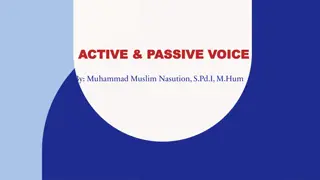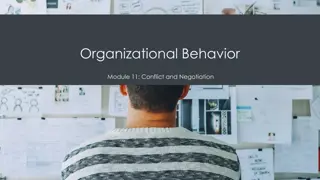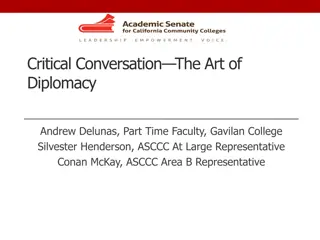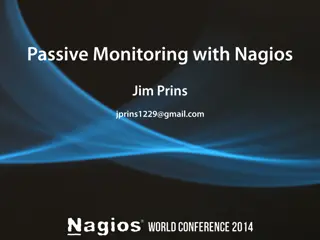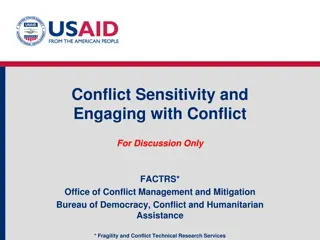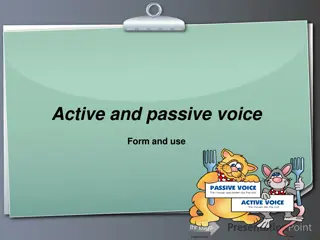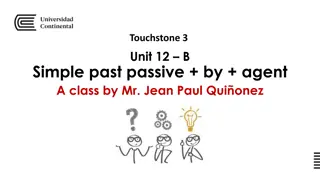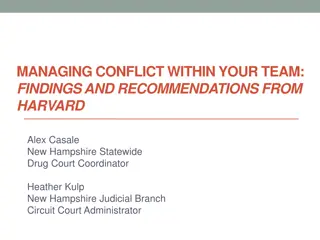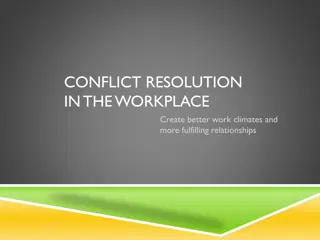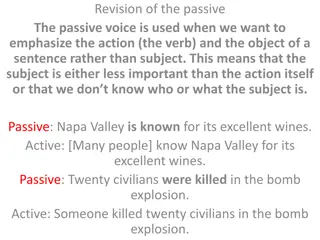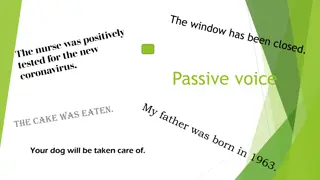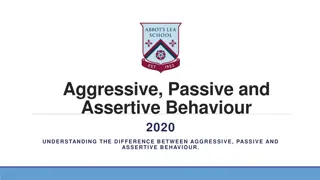Managing Conflict in the Ministerial Workplace: Passive-Aggressive vs. Aggressive Approaches
Explore the complexities of conflict resolution in the ministerial workplace, focusing on passive-aggressive and aggressive behaviors. Learn about causes of conflict, strategies for reducing it, and enhancing communication skills. Assumptions about conflict in a professional setting are discussed, along with examples of small group discussions on workplace conflicts. Understand passive-aggressive behavior and its impact on social and occupational situations. Presented by Carol Fowler, retired Director of Personnel Services at the Archdiocese of Chicago.
Download Presentation

Please find below an Image/Link to download the presentation.
The content on the website is provided AS IS for your information and personal use only. It may not be sold, licensed, or shared on other websites without obtaining consent from the author.If you encounter any issues during the download, it is possible that the publisher has removed the file from their server.
You are allowed to download the files provided on this website for personal or commercial use, subject to the condition that they are used lawfully. All files are the property of their respective owners.
The content on the website is provided AS IS for your information and personal use only. It may not be sold, licensed, or shared on other websites without obtaining consent from the author.
E N D
Presentation Transcript
PASSIVE AGGRESSIVE OR JUST PLAIN AGGRESSIVE? APPROACHES FOR MANAGING CONFLICT IN THE MINISTERIAL WORKPLACE Archdiocese of Louisville June 7, 2017
Carol Fowler Retired Director of Personnel Services Archdiocese of Chicago clfowler5455@gmail.com 312-320-9346 (Cell)
OUTLINE OF PRESENTATION PASSIVE AGGRESSIVE CAUSES OF CONFLICT GENERAL STRATEGIES FOR REDUCING CONFLICT MANAGING CONFLICT IN THE CHURCH WORKPLACE COMMUNICATION SKILLS including reflective listening and negotiation
ASSUMPTIONS Conflict, disagreements and difficulties are normal and not to be feared. (Where two or three are gathered in my name ) Conflict is not in an of itself bad. It can lead to creativity and positive change.. I will assume in this talk that you have some management responsibilities and that you have experienced conflict in the Church workplace.
Assumptions continued: The conflicts can be between: Colleagues Staff and parishioners Subordinates Your boss You want to do something about it. In this hour, we are discussing conflicts in the ministerial and professional setting rather than family or close friends conflicts.
SMALL GROUP DISCUSSION Share with your small group an example of a conflict or resistance in your workplace without sharing any identifying facts. Have you tried to address this conflict? Have your attempts at resolution failed or been successful? What factors do you attribute to that success or lack of success?
WHAT IS PASSIVE- AGGRESSIVE BEHAVIOR? (From Wikipedia) The indirect expression of hostility, e.g. Procrastination Hostile jokes Stubbornness Resentment, sullenness Deliberate and often repeated failure to accomplish requested tasks for which one is responsible
(From DSM-IV B) A pervasive pattern of negativistic attitude and passive resistance to demands for adequate performance in social and occupational situations. A habitual pattern of passive resistance to expected work requirements in reaction to both authority figures and in interpersonal contexts There is sometimes a refusal to acknowledge one s own aggression but rather he or she is blameless victim.
Passive aggressive behavior is not the same as non-violent resistance as seen by many social protesters. This person is not working toward a defined social goal
Passive aggressive behavior in the workplace Damaging to team unity and effectiveness Destructive Rather than quit, the worker is destructive to the work environment If the manager is passive aggressive, the mission of the organization is often imperiled.
CAUSES OF CONFLICT IN THE CHURCH WORKPLACE Common Contributors to Conflict and Resistance: Communication and miscommunication Staff attitudes, supervisor s attitudes, staff values Honesty/openness Work habits Treatment of others, e.g. disrespect
Causes for conflict cont: Organizational Culture Organizational change such as new hire Assess the fallout Give people a voice Address concerns Allow whatever control is possible Bring in a professional Mismatched expetations (Scott 46-47)
Causes cont: Assigned and assumed roles Pastors and/or supervisors can cause conflict by micromanaging or abdicating decision making responsibility Appearing to take sides Dividing your team Overreacting Misunderstanding the real issues Looking the other way Being dismissive
Pastors/supervisors cont: Creating ill-defined expectations and responsibilities Hiring right person for the wrong job Talking instead of listening Being judge and jury Rescuing instead of coaching
Values that are often at the heart of workplace conflict Acceptance Accomplishment Autonomy Competence Control Cooperation Recognition Respect (cf. Scott, pg. 29)
Simple Strategy Acknowledge the other person is hurt Show empathy Be patient Stay cool Understand the issues Set a vision Explore alternatives/solutions Agree on action
GENERAL STRATEGIES FOR RESOLVING RESISTANCE Behind resistance are feelings. You can t talk people out of how they are feeling. Try to help people verbalize their resistance/objections directly. It rarely works to fight the resistance head on. Try to let the resistance dissipate the way a storm dissipates. Look for neutral language to name the resistance.
General strategies cont. Suspend the J Respond rather than react Work on being flexible, resilient, nimble To manage the interaction, manage yourself. Keep your focus on the goal or preferred outcomes Be open to incremental progress Time-outs with purpose Parking lot
General strategies cont: View challenging issues as dilemmas not impasses or problems Reframe Use observation skills to understand the other The power of I While silence can be helpful briefly, it isn t helpful when used to hide the truth or the concerns
General strategies cont: Set norms and expectations for the resistance resolution conversations that are good basic communication norms as well as norms attuned to our faith. Seek to understand. Don t dismiss anyone Communio: Build a bridge, Cross the bridge, invite others to cross the bridge
General strategies cont: Vision: The What if question. Brainstorming possibilities Adopt peace keeping, peace-preserving, peace promoting language
STRATEGIES FOR RESOLVING CONFLICTS BETWEEN YOUR EMPLOYEES Assess the cost and scope of the conflict Empower staff to handle the conflict Develop a plan for mediation Prepare for a meeting Negotiate possible solutions to a conflict
Mediation meeting with two persons or a group Establish ground rules Active listening Your role Reflecting emotions Label issues Hone in on values Identify issues that cause resistance Negotiate possible solutions
SIGNS OF RESISTANCE When the resistance takes this form what can you say? One Word Answers Changing the Subject Compliance Silence Press for Solutions Attack Intransigence High Emotion/Intensity
STRATEGIES FOR HANDLING CONFLICT BETWEEN YOU AND SOMEONE ELSE Figure out your core values and ask the same of the other person Identify your hot buttons Are you a good listener Recognize your strengths Think about what the other person wants Is there common ground?
When the Conflict is with Someone you Supervise Create a dialogue Conflicts usually about: Communication Work habits Treatment Attitude Gossip Honesty In subordination
Your Approach You are in this conflict with the staff member (It takes two to tango) Put yourself in her shoes and ask how you would want your boss to approach you Set a goal for discussion that helps both of you get back on track Be honest with yourself about your part in the conflict Commit to a new approach Apologize when necessary and appropriate Keep your power in check
Your Approach with your Supervisor When is it a good idea to ask for a meeting? You are determined to stay with the organization One or both of you are new and got off to a bad start You are concerned about your reputation Respect and/or dignity have been violated Situation can t be ignored
When shouldnt you meet: Emotions are intense especially anger Relevant issues are not yet known The situation is in flux You are not ready to listen but only want to vent You are not prepared to give up being a victim .
Steps that Lead to Effectiveness Ask for a block of time that allows for in-depth conversation without distractions Have a specific goal for the meeting in mind Write down your goals and the facts as you know them before the meeting Be ready with at least 3 suggestions for decisions Apologize readily if you have erred Admit your limitations Graciously accept any apology
What Can You Control? Your responses Your perspective Your responses Your investment Your role in the conflict Your expectations Your energy
What Reasons Managers Give for Not Addressing Conflict I don t know how I don t want to open a can of worms I haven t succeeded previously Problem? What Problem? I Don t Know where to start. It s not my business I have real work to do. I don t want to have to fire anyone. I don t want to look bad.
RESOURCES Garrido, Ann, Redeeming Conflict, Ave Maria Press, Notre Dame, IN 2016 Garrido, Ann, Redeeming Adminstration, Ave Maria Press, Notre Dame, IN 2013 Senior, Donald, The Gift of Administration, Liturgical Press, Collegeville, MN 2016 Lencioni, Patrick, Death by Meeting, John Wiley & Sons, 2004
RESOURCES Conflict Resolution at Work For Dummies by Vivian Scott Perfect Phrases for Dealing with Difficult People by Susan Benjamin Perfect Phrases for Conflict Resolution by Lawrence Polsky and Antoine Gerschel Ralph Bonaccorsi, Director of the Office of Conciliation Services, Archdiocese of Chicago




